Adjusting the Printhead - iPF800 Series
| Article ID: ART129805 | | | Date published: 05/12/2015 | | | Date last updated: 08/17/2015 |
Solution
If printing is faint or streaked in different colors, make sure the Printhead nozzles are clear by printing a test pattern to check the nozzles.
Note:- You can specify a number of pages in the printer's Noz. Check Freq. menu for automatic nozzle checking every time you finish printing that quantity.
1. Load unused paper.
2. Press the Menu button to display MAIN MENU.
3. Press  or
or  to select Test Print, and then press the
to select Test Print, and then press the  button.
button.
4. Press  or
or  to select Nozzle Check, and then press the
to select Nozzle Check, and then press the  button.
button.
5. Press  or
or  to select Yes, and then press the OK button.
to select Yes, and then press the OK button.
The printer goes online and prints a test pattern.
6. Check the printing results.
The Printhead L prints the test pattern for nozzle checking on the top line in each color, and the Printhead R prints the test pattern on the bottom line.
If the horizontal lines are not faint or incomplete, the nozzles are clear.
If some sections of the horizontal lines are faint or incomplete, the nozzles for those colors are clogged.
If horizontal lines are faint or incomplete, follow the steps below and check again for nozzle clogging.
1. Clean the Printhead.
2. Print a test pattern to check the nozzles.
Note:- If you repeat these steps several times but the horizontal lines are still faint or incomplete, contact the Canon Help Desk.
If printed vertical lines are warped or colors are out of alignment, adjust the Printhead alignment.
Use Auto Head Adj. to have the printer print and read a test pattern for automatic adjustment of the printhead.
Auto Head Adj. offers two modes, Standard Adj. and Advanced Adj..
Standard Adj. will fix most slight image distortion or color misalignment, but if not, try Advanced Adj..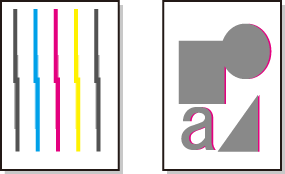
- If advanced adjustment does not improve printing results, or if you are using special paper, try manual adjustment.
- Use Standard Adj. if you have switched to another type of paper or if you want the boundaries between colors to appear as attractive as possible.
- Use Advanced Adj. to fine-tune the space between nozzles or colors if you have switched the printhead or if you want printed documents to appear as vivid as possible. We recommend using Advanced Adj. for printing at a higher level of image quality.
- Always make sure the loaded paper matches the type of paper specified on the printer. Adjustment cannot be completed correctly unless the loaded paper matches the settings.
- We recommend using the type of paper you use most often for adjustment.
- This function is not available with CAD Tracing Paper, CAD Translucent Matte Film, or CAD Clear Film. If adjustment is not possible as expected using highly transparent film or similar media, try another type of paper, or try adjust the Printhead alignment manually.
Paper to Prepare
- Rolls
An unused roll at least 10 inches wide
- Sheets
Standard Adj. : One sheet of unused paper of at least A4/Letter size
Advanced Adj. : Five sheets of unused paper of at least A4/Letter size (or one sheet when using A2 or larger, or two sheets when using A3 loaded lengthwise)
Execute Auto Head Adj. as follows.
1. Load paper.
2. Press the Menu button to display MAIN MENU.
3. Press  or
or  to select Adjust Printer, and then press the
to select Adjust Printer, and then press the  button.
button.
4. Press  or
or  to select Auto Head Adj., and then press the
to select Auto Head Adj., and then press the  button.
button.
5. Press  or
or  to select Standard Adj. or Advanced Adj., and then press the
to select Standard Adj. or Advanced Adj., and then press the  button.
button.
6. Press  or
or  to select Yes, and then press the OK button.
to select Yes, and then press the OK button.
A test pattern is printed for printhead adjustment.
Adjustment is now finished if you have printed on a roll or a sheet of A2 size or larger.
7. If you are printing on sheets smaller than A2 size for Advanced Adj., a confirmation message is displayed asking you whether to continue printing. Press the OK button and follow the instructions displayed.
If printed vertical lines are warped or colors are out of alignment, adjust the Printhead alignment.
With Manual Head Adj, you can manually adjust the Printhead alignment by printing and reading a test pattern.
You can adjust the Printhead alignment automatically or manually. Normally, choose automatic adjustment. If advanced adjustment does not improve printing results, or if you are using special paper, try manual adjustment.
- If Manual Head Adj is not available although displayed in the menu, choose Advanced Adj. in Auto Head Adj.. Manual Head Adj is available in the menu after you try Advanced Adj. once.
- Always make sure the loaded paper matches the type of paper specified on the printer. Adjustment cannot be completed correctly unless the loaded paper matches the settings.
- We recommend using the type of paper you use most often for adjustment.
Paper to Prepare
- Rolls
An unused roll at least 10 inches wide
- Sheets
One sheet of unused paper of at least A4/Letter size
Execute Manual Head Adj as follows.
1. Load paper.
2. Press the Menu button to display MAIN MENU.
3. Press  or
or  to select Adjust Printer, and then press the
to select Adjust Printer, and then press the  button.
button.
4. Press  or
or  to select Manual Head Adj, and then press the
to select Manual Head Adj, and then press the  button.
button.
5. Press  or
or  to select Yes, and then press the OK button.
to select Yes, and then press the OK button.
A test pattern is printed for printhead adjustment.
6. Press  or
or  to select D, and then press the
to select D, and then press the  button.
button.
7. Press  or
or  to select D-1, and then press the
to select D-1, and then press the  button.
button.
8. Examine test pattern D-1 for printhead adjustment and determine the number of the pattern with straight lines.
- If lines seem straightest in two patterns but you cannot decide which one is better, choose an intermediate value. For example, choose 11 if you cannot decide whether pattern 10 or 12 is better.
9. Press
 or
or  to select the pattern number, and then press the OK button.
to select the pattern number, and then press the OK button.10. Repeat steps 7 and 9 to specify the adjustment value for D-2 to D-5 and D-7 to D-11.
11. Press the  button.
button.
12. Press  or
or  to select Register Setting, and then press the
to select Register Setting, and then press the  button.
button.
13. Press  or
or  to select Yes, and then press the OK button.
to select Yes, and then press the OK button.
The adjustment value is now registered, and adjustment is complete.
If printed lines are misaligned, try adjusting the angle of the Printhead. Even slight misalignment can be corrected. Adjust the Printhead orientation by printing and reading a test pattern.
Paper to Prepare
- Rolls
An unused roll at least 10 inches wide
- Sheets
One sheet of unused paper of at least A4/Letter size
Execute Head Inc. Adj. as follows.
1.Load the paper.
Note:- When loading paper, specify the type of paper correctly. Using paper that you have not specified on the printer may cause feeding problems and affect the printing quality.
- We recommend loading a type of paper that you use often.
2. Press the Menu button to display MAIN MENU.

3. Press  or
or  to select Adjust Printer, and then press the
to select Adjust Printer, and then press the  button.
button.
4. Press  or
or  to select Head Inc. Adj., and then press the
to select Head Inc. Adj., and then press the  button.
button.
5. Press  or
or  to select Yes, and then press the OK button.
to select Yes, and then press the OK button.
After the Printhead is moved, a message is displayed requesting you to open the Top Cover.
6. Open the Top Cover.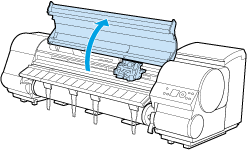
7. Align the Angle Adjustment Lever with the red square and close the Top Cover.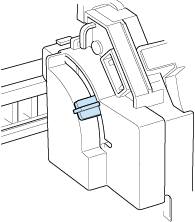
A test pattern is printed for adjustment.
- Do not touch the Linear Scale (a), Carriage Shaft (b), or Ink Tube Stabilizer (c). Touching these parts may damage them.
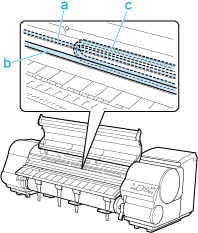
8. Examine the test pattern for adjustment. Determine the straightest set of lines.
9. Open the Top Cover and move the Angle Adjustment Lever to match the number (or the square) of the straightest set of lines.
If no single set of lines is perfectly straight, move the Angle Adjustment Lever to a position between the numbers (or between the number and the square) of the two sets of lines that are least misaligned.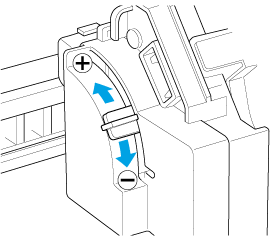
10. Close the Top Cover.
The Printhead is now straight, and adjustment is complete.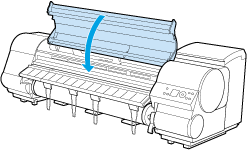
If paper rubs against the printer or the edge is wrinkled from rubbing, adjusting the Printhead height may improve results.
If image edges are blurred, it may help to lower the Printhead.
1. Press the Menu button to display MAIN MENU.
2. Press  or
or  to select Paper Details, and then press the
to select Paper Details, and then press the  button.
button.
3. Press  or
or  to select the type of paper, and then press the
to select the type of paper, and then press the  button.
button.
4. Press  or
or  to select Head Height, and then press the
to select Head Height, and then press the  button.
button.
5. Press  or
or  to select the Printhead height, and then press the OK button.
to select the Printhead height, and then press the OK button.
